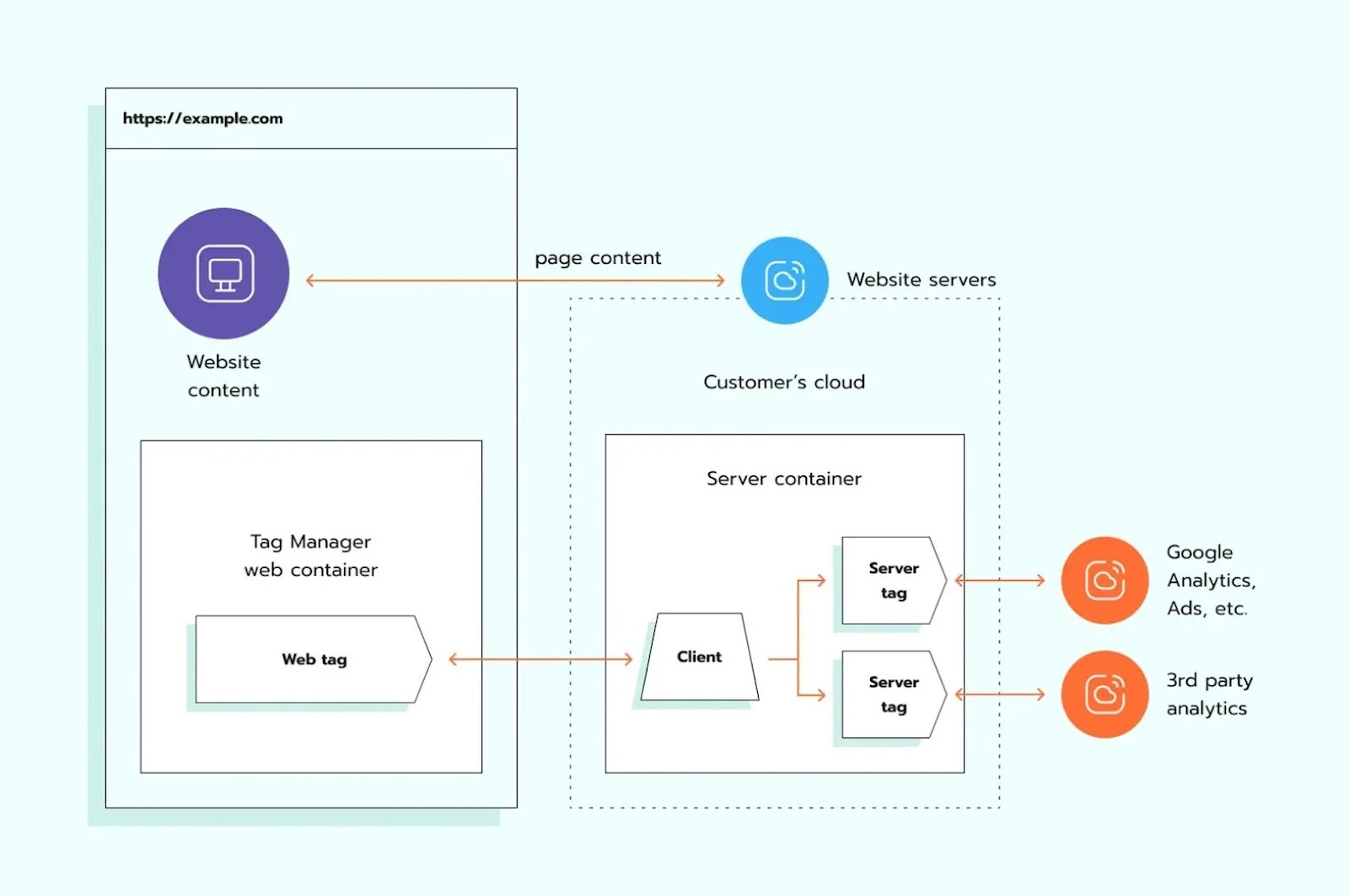How to Set Up GA4 Tracking Using Google Tag Manager
Setting up GA4 tracking with a GTM server-side container enhances data accuracy and privacy by processing data on your server. This method bypasses ad blockers and browser restrictions, while allowing you to filter or anonymize data, ensuring compliance and better security.

Setting up Google Analytics 4 (GA4) tracking using a Google Tag Manager (GTM) server-side container can significantly enhance your data collection and privacy controls. This guide will walk you through each step, helping you leverage this setup to maximise the accuracy and security of your data.
Introduction to Server-Side Tracking
Server-side tracking lets you collect and process data on your server rather than in the user’s browser. This approach provides enhanced control over the data you collect, allowing you to filter or anonymise information before sharing it with analytics platforms like GA4. Server-side tracking also helps bypass limitations like ad blockers and browser restrictions, improving data reliability and helping maintain compliance with privacy regulations.
When using a server-side container with GA4, data flows from your website to the GTM server-side container, which then sends it to GA4. This extra layer allows you to manage the data more effectively and securely.

If you're new to the concept, check out our article on what is Google Tag Manager server-side tracking to understand the basics before diving into the setup process.
Benefits of GA4 Server-Side Tracking
Using GA4 with a GTM server-side container offers numerous advantages:
- Enhanced Data Accuracy: With server-side tracking, data is less likely to be affected by ad blockers and other browser-based restrictions, leading to a more complete and accurate dataset.
- Improved Privacy Control: You can apply privacy controls directly within your server environment, such as IP anonymization or data redaction. This setup lets you comply with privacy regulations while ensuring only necessary data is sent to GA4.
- Better Data Ownership and Security: By managing data processing within your own server infrastructure, you gain greater ownership and control over the data you collect, reducing reliance on third-party services.
- Reduced Client-Side Load: Server-side tracking reduces the load of scripts and tags on the client side, which can improve website performance and user experience by reducing page load times.
Prerequisites
Before you begin setting up GA4 tracking with a GTM server-side container, make sure you have the following:
- Google Analytics 4 Property: If you don’t already have one, create a new GA4 property in your Google Analytics account. This property will be used to store the data you collect.
- Google Tag Manager Account: Access to GTM with permissions to create and manage containers is required. If you don’t have a GTM account, you can sign up for free.
- Server Environment: A server environment to host your GTM server-side container. While Google Cloud Platform (GCP) is the most commonly used solution, other cloud providers like AWS and Azure can also be used. Note that server-side tracking may incur additional costs for server hosting.
Step 1: Create a GTM Server-Side Container
Creating a GTM server-side container is the first step to implementing server-side tracking.
- Access GTM: Log in to your Google Tag Manager account.
- Create a New Container
- Go to the Admin section in GTM.
- Click Create Container.
- Name your container, select Server as the container type, and then click Create.
- Set Up the Container:
- After creating the container, you’ll see a prompt to set up your tagging server.
- You can choose between automatic provisioning on the Google Cloud Platform (recommended for beginners) or manual setup if you prefer more control over the server infrastructure.
- Helpful Tips:
- Name your server container descriptively, especially if you manage multiple containers.
- Consider the future scalability of your server setup. GTM offers flexibility, but configuring your container well now will save time later as your tracking needs expand.
Step 2: Deploy the Tagging Server
Once the server-side container is created, it’s time to deploy the tagging server.
- Automatic Provisioning
- Choose Automatic Provisioning if you want GTM to handle the setup for you.
- GTM will create a new Google Cloud Platform (GCP) project and deploy the tagging server, automatically configuring the App Engine and storage.
- Follow the on-screen instructions to complete the setup. After deployment, GTM provides a unique server URL for your container.
- Manual Setup
- If you prefer manual control, you can deploy the server on GCP or another hosting provider.
- This requires creating a GCP project, setting up App Engine, and deploying the GTM server-side container. You’ll also need to configure the domain settings and any custom security measures.
- Refer to Google’s developer documentation for detailed instructions on manual setup.
Suggestion: For advanced setups, configure a custom subdomain (e.g., analytics.yourwebsite.com) for your server container URL. This makes it easier to manage and provides a professional touch.
Step 3: Configure GA4 in the GTM Web Container
Configure a GA4 tag in your GTM web container to route data to your server container before it reaches GA4.
- Create a GA4 Configuration Tag
- In your GTM web container, go to Tags and click New.
- Select Google Analytics: GA4 Configuration as the tag type.
- Enter your GA4 Measurement ID, which you can find in your GA4 property settings.
- Set this tag to fire on all pages or on specific events, depending on your tracking requirements.
- Set Up Server-Side Data Transfer:
- Add a new field in the tag settings
- Field Name: transport_url
- Value: The unique URL of your GTM server container (e.g., https://analytics.yourwebsite.com)
- This configuration directs data to your server container, which processes it before sending it to GA4.
- Add a new field in the tag settings
You can also use the server container to filter or modify the data collected on the client side, giving you more control over data quality and compliance.
Step 4: Set Up the GA4 Client in the Server Container
Now that your server container receives data set up a GA4 client to process incoming requests.
- Create a GA4 Client:
- In your GTM server container, go to Clients and click New.
- Choose Google Analytics: GA4 as the client type.
- Save the client configuration without making any other changes.
- Create a GA4 Tag in the Server Container:
- In the server container, navigate to Tags and click New.
- Select Google Analytics: GA4 as the tag type.
- Leave the Measurement ID and Event Name fields empty to allow the values to be inherited from incoming requests.
- Set the trigger to fire on all events processed by the GA4 client.
Tip: The GA4 server-side client acts as a data processor. You can apply custom rules, filters, or data transformations within the server container before sending data to GA4, which is particularly useful for large or complex tracking setups.
Step 5: Test and Validate Your Setup
Testing your setup is crucial to ensure that data flows smoothly and accurately from your website to the server container and then to GA4.
- Preview Mode:
- Use GTM’s Preview Mode to test the setup.
- Verify that events are correctly sent from your website to the server container and then to GA4.
- Check that data fields are being processed accurately by the server container.
- Check GA4 Reports:
- In GA4, navigate to Real-Time Reports to confirm that data is being received as expected.
- Monitor the reports to ensure that all events and parameters are captured accurately.
Consider testing your setup across different browsers and devices to confirm that data collection remains consistent.
FAQ
What is the primary advantage of server-side tracking over client-side tracking?
Server-side tracking offers enhanced data control, improved accuracy, and better compliance with privacy regulations, particularly with users with enabled ad blockers or privacy tools.
Are there additional costs involved in server-side tracking?
Yes, server-side tracking often requires hosting fees for the server container. Depending on traffic volume and server configuration, you may incur costs for App Engine if you use GCP.
How does server-side tracking improve website performance?
By offloading tracking scripts
Conclusion
GA4 tracking with a Google Tag Manager server-side container enhances data accuracy, privacy, and website performance. Though setup requires some technical effort, the improved control and future-proofing for privacy compliance make it a valuable addition to any analytics strategy.
